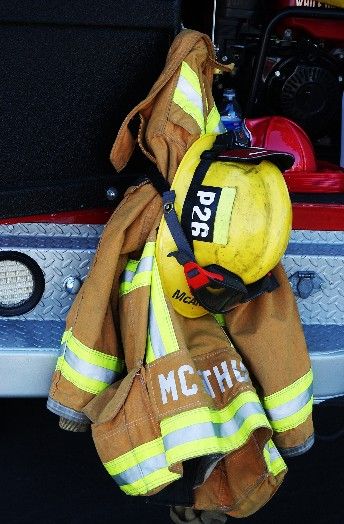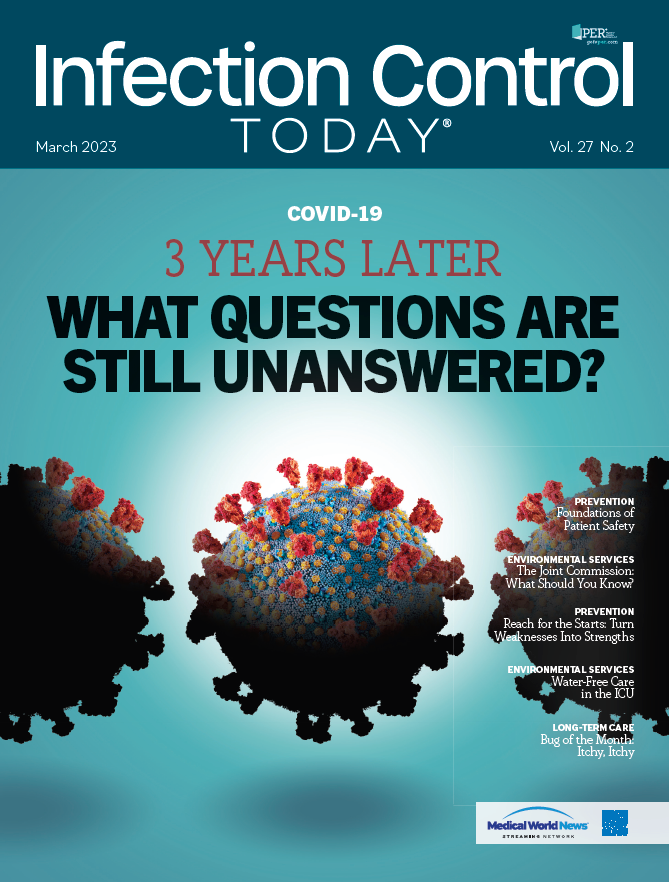First Responders Tackle Infection Control and Prevention Challenges
How did first responders and firefighters navigate the COVID-19 pandemic and its aftermath? Two firefighters/EMTs describe what that time was like for them.
Firefighter coat and helmet
(Adobe Stock 3161418, weberfoto)

For first responders, including emergency medical services (EMS) personnel and firefighters, safety isn’t just about getting home alive. It’s also about making conscious decisions to protect themselves and their patients from infectious materials of all types.
Working as an emergency medical technician or firefighter comes with known and unknown risks. The many safety protocols that must be followed include infection control and use of personal protective equipment (PPE). PPE can range from nitrile gloves and a surgical mask to a fully incapsulating suit with an independent air supply. Protocols help us determine what is appropriate for the call we are responding to.
The National Institute for Occupational Safety and Health and the CDC research and make recommendations for the prevention of work-related injury and illness. Similar to other occupations, individual departments can strengthen and go above the recommendations given.
In 2020, when the COVID-19 pandemic began, everything in the health care field was flipped upside down. First responders, nurses, doctors, and anyone working with patients had no idea of the changes and shortages that were about to occur. We grew to hate wearing the mandated N95 respirator masks. At first, it was not so bad; you could hide your bad breath from your coworkers and hide your tired face after getting up at 3 AM.
After a month of being worn continuously, the masks began to smell and discolor, leaving a reminder of the last call you went on. For many months as frontline paramedics, we were told to use these masks sparingly. “We have a limited supply, and we cannot get any more soon,” our supervisors told us. N95s, along with most respiratory protection masks, are not made for this kind of wear. They are supposed to be disposed after being contaminated. How helpful was it to health care workers to reuse potentially contaminated masks for weeks and months?
Some supervisors recommended microwaving the masks to help kill the bacteria on the masks. It was only months later that commercial companies started coming out with innovative cleaning materials for the masks.
Hospital employees who were working with patients with COVID-19 were provided with disposable gowns and extra gloves to help against risk exposure, but those of us working in the EMS services received rain protectors and garbage bag–like gowns that were restrictive and uncomfortable. These “gowns” caused many of us to question how important we were and whether what we were doing really mattered. Morale was at an all-time low, with the feeling that no one cared about our protection or our families that we were going home to. Many of us exposed to infection were quarantined from the very people we needed most. Although first responders were doing their best to help lower the exposure rate, there were some first responders who were uninformed and uneducated about SARS-CoV-2 and the risks that came with it.
Health care and EMS services were inundated with record-breaking numbers of critically ill patients. These unprecedented numbers of patients caused shortages in hospital rooms, which in turn caused longer wait times for EMS personnel to transfer care of their patients.
Today, first responders have easier access to information, but there is still a question of whether the information they receive is factual. Although the CDC was doing its best to provide accurate data and put safety procedures into place for the public and health care during the pandemic, it often appeared some of the media were giving out incorrect information. Both health care and the public were at the mercy of conflicting information, which made it difficult to protect ourselves.
The public often had no idea what was truly going on. Health care and EMS services were inundated with record-breaking numbers of critically ill patients. These unprecedented numbers of patients caused shortages in hospital rooms, which in turn caused longer wait times for EMS personnel to transfer care of their patients. Facilities were understaffed and workers were burned-out. Burnout often leads to complacency within the workplace, and the effects showed at every facility we went to, from short tempers to lackadaisical work ethic.
As time went on, PPE shortages grew worse, and EMTs and other first responders as well as other health care workers became more accustomed to being in environments with possible exposures without the proper equipment needed to protect themselves. When these PPE items became more readily available, many workers were already complacent about being infected with COVID-19. N95 masks were swapped for the much more accessible surgical masks, and protective gowns became a thing of the past.
One of the most effective ways to combat complacency is training in patient care safety. Healthy habits can become ingrained through proper training and accurate, up-to-date information.
Employers can help to combat employee burnout by providing the resources they need and developing a professional, yet friendly, environment between administration and employees. Employers can also help by providing an atmosphere where their employees feel provided for and cared for. Health care employers should help provide the public with educational information about infectious diseases and how to provide proper self-care at home.
Although health care will always be a revolving door with constant change, lessons we’ve learned over the past few years hopefully will help pave the path to safer work environments. Infection control will always be at the forefront of health care. Therefore, training and being open-minded to the ever-changing world around us is vital to keeping each other and ourselves safe.

Redefining Material Compatibility in Sterilization: Insights From AAMI TIR17:2024
March 24th 2025AAMI TIR17:2024 provides updated, evidence-based guidance on material compatibility with sterilization modalities. It offers essential insights for medical device design and ensures safety without compromising functionality.
Unraveling a Candida auris Outbreak: Infection Control Challenges in a Burn ICU
March 19th 2025A Candida auris outbreak in a burn intensive care unit (BICU) in Illinois has highlighted the persistent challenges of infection control in high-risk health care settings. Despite rigorous containment efforts, this multidrug-resistant fungal pathogen continued to spread, underscoring the need for enhanced prevention strategies, environmental monitoring, and genomic surveillance.
Unmasking Long COVID: Dr Noah Greenspan on Recovery, Research Gaps, and the Future of Treatment
March 18th 2025Dr Noah Greenspan discusses the evolving understanding of long COVID, current treatment strategies, diagnostic challenges, and the critical need for research and awareness in post-viral syndromes.